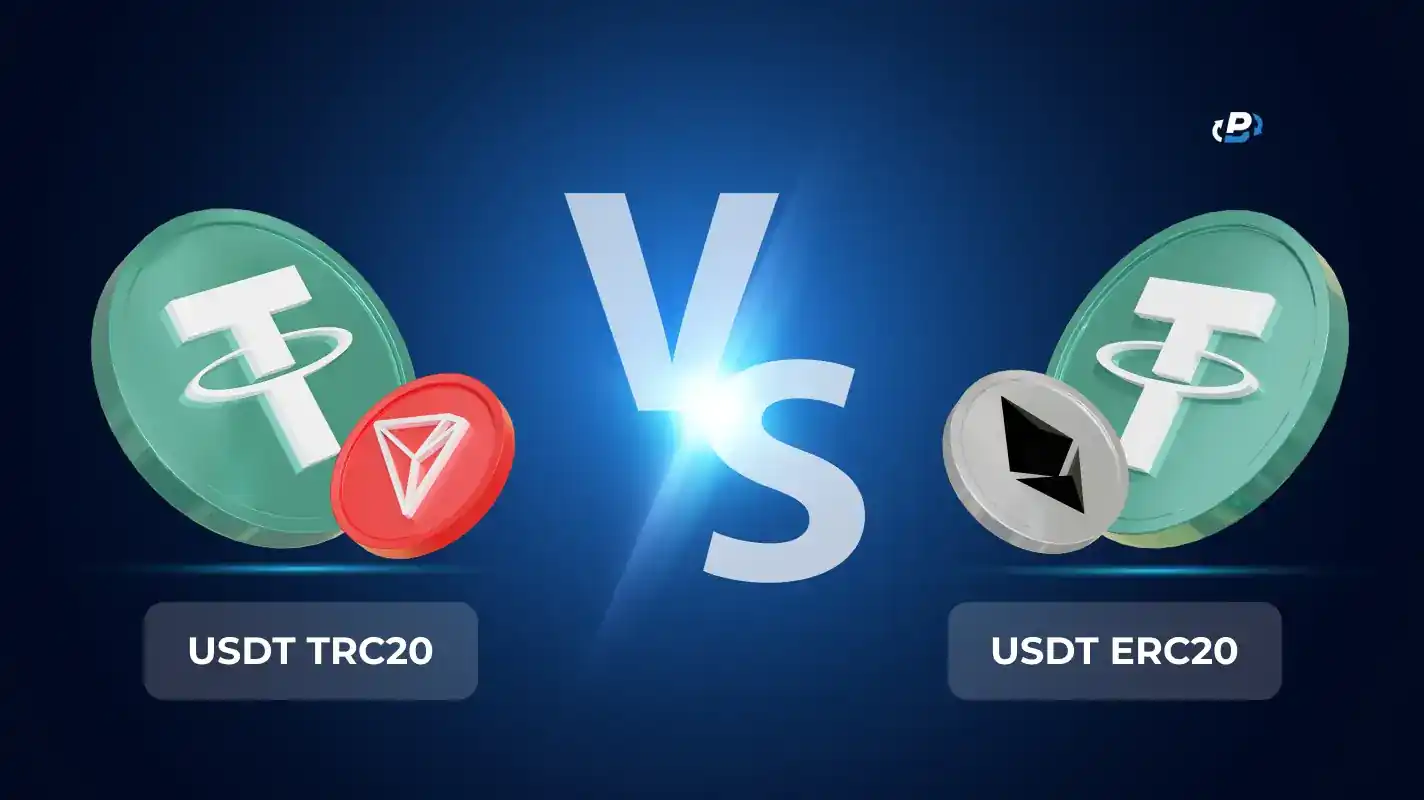USDT is one of the most widely used stablecoins, available on multiple blockchains, including Ethereum (ERC-20) and Tron (TRC-20). One important thing many users miss is that you can't just move it between networks directly, despite being the same token. For example, if you have USDT on Ethereum and try to send it to a Tron wallet, it won’t go through, and even worse, you will lose your funds. Every crypto holder, whether you're holding funds in USDT to avoid volatility or just using it for payments, needs to understand that moving USDT between networks isn’t as simple as sending it from one wallet to another. If you swap it through exchanges, it will cost you unnecessary fees, often as high as 0.5% or more. But if you know how to do it right, it will cost you as little as 5 USDT.
Here's how you can avoid high fees and pay no more than 10 USDT when figuring out how to exchange USDT ERC20 to USDT TRC20? You can use any centralized exchange and deposit your USDT to the USDT ERC20 address (Ethereum), and withdraw your USDT on TRC20 (Tron network) to your USDT TRC20 address, basically paying only the withdrawal fee and not paying any exchange fee. Do not use decentralized exchanges because you will pay an exchange fee, which will cost you a lot of money.
Creating a bridge to connect the Tron and Ethereum networks
If you’re not super into crypto yet, it can be tricky to understand how different networks like Ethereum and Tron work. To better understand it, think of USDT like a train, and each blockchain network, Ethereum (ERC20) or Tron (TRC20) as completely separate sets of train tracks that don’t connect. You can’t just pick v up a train running on Ethereum rails and drop it onto Tron rails. The train (your USDT) can run on either set of tracks, but it can’t just jump from one track to another. So, if you’ve got USDT on the Ethereum tracks and you want it on the Tron Track, you need to use a “rail switch” in order to move the train from one track to the other, in our case it's a centralized crypto exchange. You send your USDT train into the exchange on the ERC20 track, and they’ll exchange it for the same amount of USDT on the TRC20 track, simple as that. And since you're not actually swapping tokens, you're just changing the tracks they run on, the only cost is the withdrawal fee, not the exchange fees you'd pay if you used a decentralized exchange.
What are the main differences between the Ethereum and Tron networks?
You can have USDT on both Ethereum and Tron networks, but moving it between the two chains is not possible without a third-party solution like an exchange. The most important differences between the Ethereum and Tron networks are speed, fees, and decentralization. Transaction speed is significantly faster on the Tron network, capable of processing over 2000 transactions per second. It also comes with smaller fees because of the network bandwidth and energy model. The Ethereum network can process around 30 transactions per second, which can be improved with scaling solutions. Gas fees can change dramatically, and they can be pretty expensive during busy periods.
The Ethereum network uses a Proof-of-Stake consensus mechanism where thousands of validators are chosen randomly by staked ETH. It means the network is highly decentralized and has strong security. Tron focuses on fast and cheap transfers, and it accomplishes that with delegated Proof–of-Stake consensus. Then the network uses 27 “super representatives” chosen by voting every six hours. Because fewer parties control block production, it improves the speed and cost. So, if you hold USDT on the ERC-20 network and need faster or more frequent transactions, consider moving your USDT to the Tron network for quicker and more cost-efficient transfers.
What is a Centralized exchange?
One of the easiest ways to change the same tokens between two different networks is a centralized exchange like PlasBit. Essentially, CEX is an online platform that allows you to buy, sell, or swap cryptocurrencies. The exchange acts as a middleman in your transactions, and CEX will hold your funds and handle all transactions for you. Some of the most popular exchanges are Binance, Coinbase, and PlasBit. To move your assets, you must create an account and verify your identity (KYC) to use them. From the crypto owner's perspective, CEX is a trusted third-party platform that helps you make crypto trades fast and easy. The biggest benefit of using CEX is that there are no network or gas fees when exchanging tokens between different networks, and you only pay for withdrawal fees.
In-depth guide on how to transfer USDT on Ethereum to USDT on the Tron network
If you’re looking for the easiest and most affordable answer to the central question of the article on how to exchange USDT ERC20 to USDT TRC20, using a centralized exchange is the way to go. Here is a detailed guide on exchanging USDT from Ethereum to the Tron network through a PlasBit centralized exchange.
1. First, you should log in to your Plasbit wallet and go to the "Deposit" tab. Choose the cryptocurrency you would like to exchange, either scan the QR code or manually copy your external wallet's address and paste it in the box, then choose the network you are depositing from:

2. In the next step, once the transaction is complete, go to the "Withdraw" tab, fill in the TRC20 address you want to withdraw to. Under "Transfer Network," choose the Tron network, decide the amount you are going to transfer, and then submit the request.
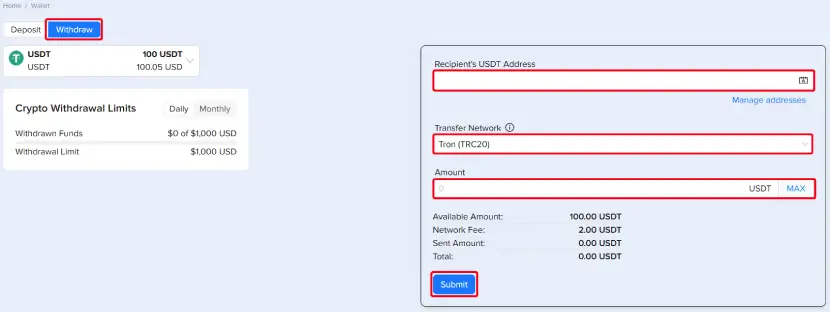
3. Click on one of the "Send" buttons, and both verification codes (Email and Phone) will be sent to you.
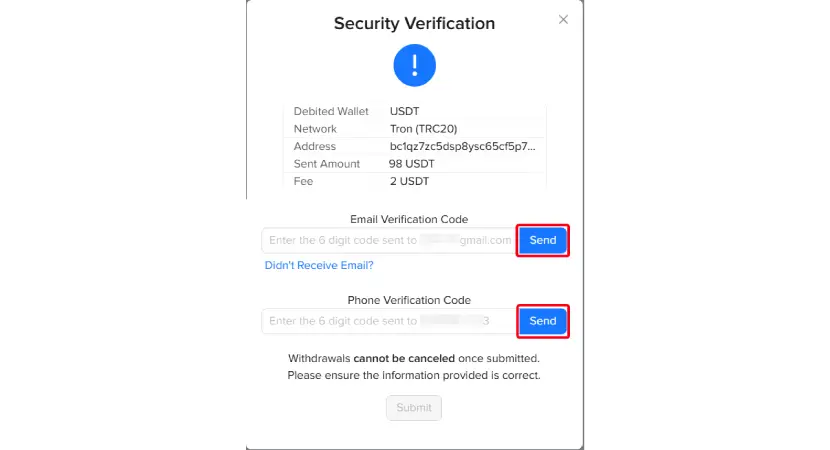
4. Fill in both codes you received through Email and your Phone and click "Submit". The withdrawal request will be submitted and processed.
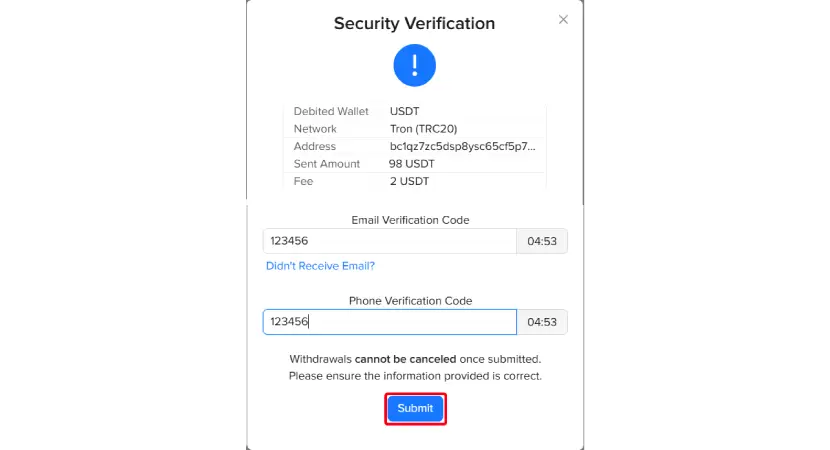
A centralized exchange is an all-in-one solution for transferring USDT between the Ethereum and Tron networks, offering a straightforward way to transfer tokens and being price-effective compared to other solutions, as you only pay a withdrawal fee.
Using a decentralized exchange to transfer USDT
If you use CEX, the clear benefits are quick and seamless exchange with only a withdrawal fee. However, some users prefer decentralized exchanges like StealthEx, and their primary benefit is increased privacy. DEX exchanges can maintain your privacy by not requiring KYC (Know Your Customer) verification, allowing you to keep your anonymity, but this comes with a cost.
The downside of DEX is an exchange fee that can be as high as 1.2% of your transaction. That means if you exchange 100,000 USDT ERC20 to USDT TRC20, you can pay a 1200 USDT exchange fee, which is very high. Conversely, centralized exchanges have only the withdrawal fee, which is somewhere between 5 and 10 USDT.
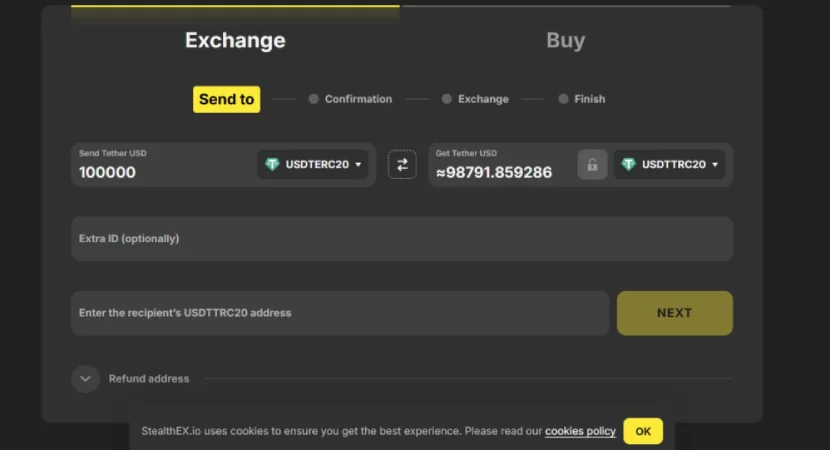
Not all decentralized exchanges can exchange USDT between the Ethereum and Tron networks. Those who can will have the fees as mentioned above, and the transactions are considerably slower. So, if privacy isn't your concern, there aren’t many benefits to using DEX compared to a quick and cost-effective centralized exchange.
How to swap USDT ERC20 to USDT TRC20 on Trust Wallet?
Centralized and decentralized exchanges are not the only answer to our main challenge of how to exchange USDT ERC20 to USDT TRC20. One of the more convenient ways to do it is by using Trust Wallet, another option for cross-chain token swapping. The Trust Wallet acts as an intermediary where you can initiate a swap and receive USDT on the Tron network through this service. So, how to swap USDT ERC20 to USDT TRC20 on Trust Wallet? Open the Trust Wallet extension or app, type USDT in the search bar, and turn on both USDT ERC20 and USDT TRC20 networks. Then, go to the swap section, choose the correct network and token in the corresponding boxes, and submit the swap request.
Detailed guide for Trust Wallet USDT swap
Here is a detailed guide if you decide to exchange your USDT between the Ethereum and Tron networks using Trust Wallet.
1. Log in to your TrustWallet account and click on the search icon, and search for USDT:

2. Make sure the USDT Ethereum and USDT Tron options are turned on:
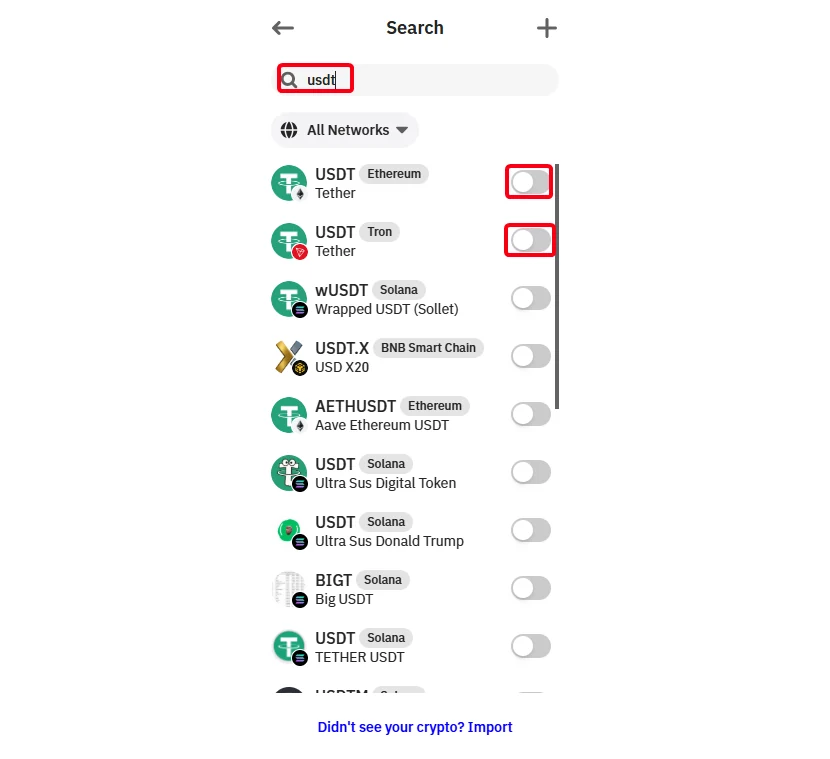
3. Go back to the main panel and click on the swap icon:
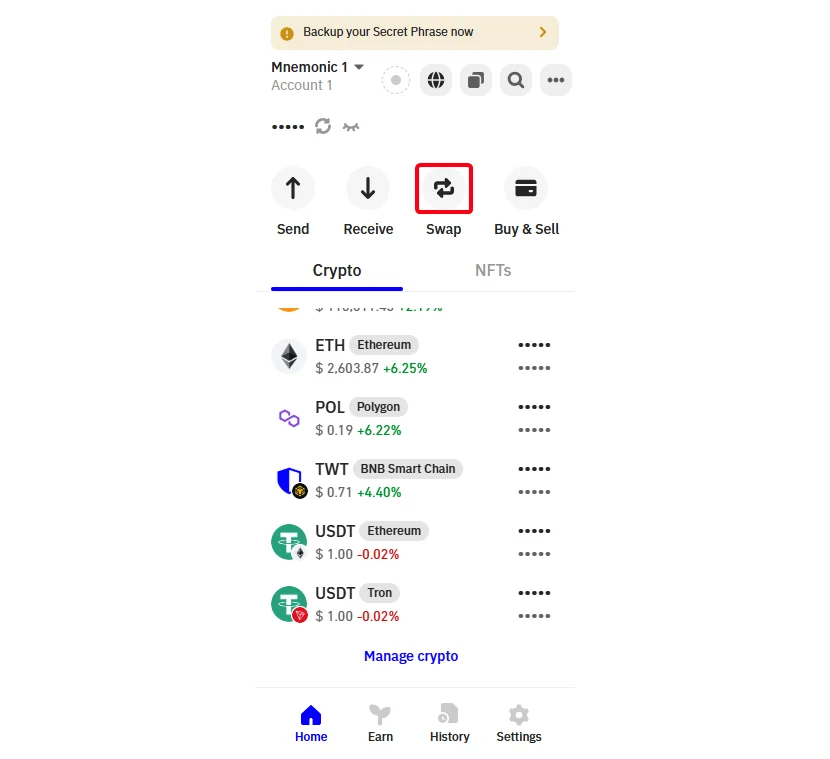
4. In the first box (From), choose the Ethereum network, and below it, choose USDT.
In the second box (To), choose the Tron network, and below it, choose USDT.
Double-check to make sure you have chosen everything correctly, and click on "Approve" to submit the transaction:
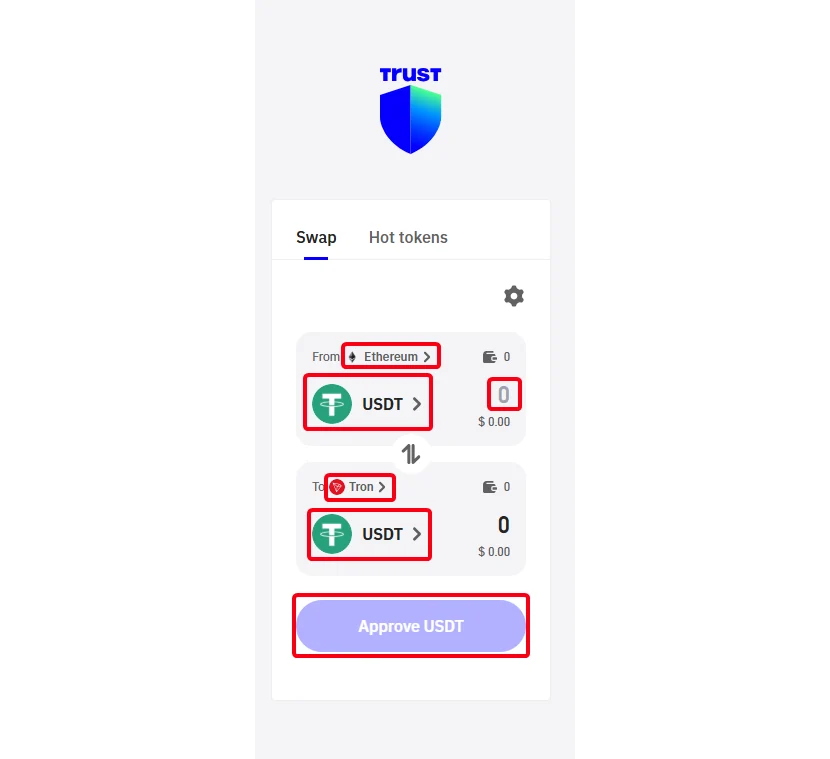
Although swapping your USDT with Trust Wallet may seem convenient and efficient, the fees can still be higher than the withdrawal fee on CEX.
What is a Crypto Bridge?
As we described, USDT on the Ethereum and Tron networks operates on two different networks, Ethereum ERC20 and Tron TRC20. One of the popular options to bridge this gap is literally called a bridge, a tool that enables you to transfer tokens between different blockchain networks. Crypto bridges are protocols that allow assets like USDT to be transferred between different blockchains. Most follow a lock-and-mint process, where the token being transferred is locked in a smart contract, and an equivalent wrapped token is minted or released on the destination chain. One of the most popular crypto bridges is Polygon, and while it doesn’t support the Tron network, you can use it for cross-chain exchange between Ethereum and Polygon. You will need a compatible wallet like MetaMask to use the Polygon bridge.
Crypto bridges provide a method for exchanging USDT between networks. Unlike centralized exchanges, which only charge withdrawal fees, they impose a bridging fee of 0.05% to 0.3%, as well as source and destination network gas fees, which can add up. In general, a crypto bridge works by locking the original tokens on the source network and minting wrapped tokens on the destination network. A centralized exchange (CEX), on the other hand, holds reserves of each token on different networks. It credits your balance when you deposit, and when you withdraw to another network, it processes the transfer internally, charging only a withdrawal fee. A decentralized exchange (DEX) operates using smart contracts to swap tokens within the same network, but not all DEXs support cross-chain swaps by default.
Comparison: How CEX, DEX, and Crypto bridge exchange tokens between networks
We created a table to illustrate the main differences between using centralized exchange, decentralized exchange and crypto bridge.
| Centralized exchange (CEX) | Decentralized exchange (DEX) | Crypto bridge | |
|---|---|---|---|
| How it works | Holds reserves, and credits the user’s balance, processes the withdrawal on a new network | Trades via smart contracts (AMMs, liquidity pools) | Typically locks the original, and mints a wrapped token |
| Example | Exchange USDT from ERC20 to TRC20 via deposit and withdrawal | Swap USDT for USDC on the same or a different chain | Move ETH from Ethereum to Polygon as wETH |
| Custody | Custodial - the exchange holds your funds | Non-custodial - users retain the keys | Usually non-custodial, but can also be custodial |
| Fees | CEX has only the withdrawal fee | DEX has trading and network fees | Has bridging and gas fees |
| Speed | Very fast after confirmation of the deposit | Depends on the network speed, it is slower than CEX | It varies depending on the networks in exchange, it can take between minutes and hours |
What is the cheapest way to exchange USDT ERC20 to USDT TRC20?
Regardless of how you want to exchange USDT between the Ethereum and Tron networks, a cost is involved. All methods have both benefits and drawbacks, and users must weigh the most important aspects for themselves. That said, cost-effectiveness is the leading factor for many crypto owners, as you don’t want the overblown fees, especially if you want to move large amounts between networks. So, what is the cheapest way to exchange USDT ERC20 to USDT TRC20? Use a centralized exchange to deposit your USDT to the USDT ERC20 address (Ethereum), and then withdraw your USDT on TRC20 (Tron network) to your USDT TRC20 address. By doing so, you avoid the exchange fee and only pay the withdrawal fee. Do not use decentralized exchanges because you will be charged an exchange fee, which will cost you a lot of money.
How to exchange USDT Solana to USDT TRC20
Exchanging USDT on a centralized exchange works for more networks other than Ethereum and Tron, which means you can use PlasBit's CEX to transfer USDT Solana tokens from Solana to the Tron network. The core principle is the same, and these transactions also have the same benefits. Here is how to exchange USDT Solana to USDT TRC20? Deposit your USDT to a USDT SOL (Solana network) address on a centralized exchange, after that, withdraw your USDT on TRC20 (Tron) network to your USDT TRC20 address. You'll only pay the withdrawal fee, with no extra exchange fees. You can also use a bridge or swap service that supports USDT transfers between the Solana and Tron networks. Avoid using decentralized exchanges because the exchange fees are high will cost you a lot of money.
How to swap USDT TRC20 to USDT ERC20?
Just like you can exchange USDT ERC20 to USDT TRC20, it works seamlessly the other way around, and again, with the same benefits if you use a CEX like PlasBit. So, how to swap USDT TRC20 to USDT ERC20? You can use any centralized exchange to deposit your USDT to the USDT TRC20 address (Tron network), and withdraw your USDT on TRC20 to your USDT ERC20 address (Ethereum), basically paying only the withdrawal fee and not paying any exchange fee. You should not use decentralized exchanges because you will have to pay an exchange fee, which can cost you a lot of money.
Conclusion
If you're holding USDT on Ethereum and want to move it to the Tron network, a centralized exchange remains a cheap and user-friendly method. Unlike decentralized exchanges, crypto bridges, or Trust Wallet swapping, CEX allows you to deposit and withdraw across networks, paying only a withdrawal fee, and it only charges a withdrawal fee, which is usually up to 10 USDT. Decentralized exchanges are charging Exchange fees that can be as high as 1.2% of the transaction amount which can reach hundreds of dollars in commissions. There are multiple correct answers on how to exchange USDT ERC20 to TRC20 however, While bridges and decentralized exchanges offer more control and privacy, they often come with higher fees and more complexity. For most users using a CEX is the simplest and cheapest way to go.




